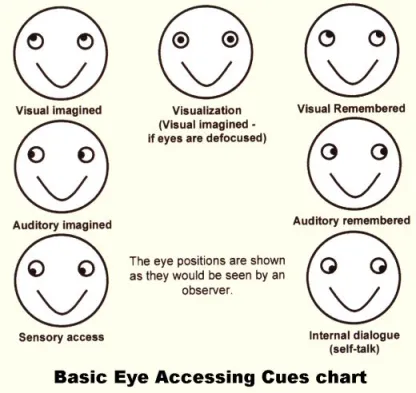The significance of eye contact in the job interview

Figure 2-Eye contact during the job interview (http://pinayla.blogspot.ca/2012/02/going-for-job-interview-read-this-first.html)
With the development of high technology, more and more people develop their communication skills on the Internet. Even the shy people can also talk to others in an active way on line. Because of this current situation, people may decrease their conversation skills when they face to face. It means that as they do not need to use body language communicate on line, people will feel nervous when they need use body language to show your emotion in a face-to-face communication. Body language is an important tool for people to have in a conversation, especially for job interview. During the job interviews, instead of the voice, the majority of attention will be focused on one’s eyes. “In the United States, making eye contact is interpreted as showing interest, paying attention, and a sign of self-confidence.” (1)
Eye contact is one type of the body language. It means when people talk to others, looking at their eyes can help them get more information about what they are saying. The same eye contacts in different situations can have many meanings. For instance, look down is one of the eye languages. When people cannot answer the questions that interviewers ask, he/she will look down at the floor instead of directly look at interviewer’s eyes, it shows he/she is not confidence enough under this situation. However, the gesture of looking down can also mean people do not appreciate others comments. In job interview, eye contact is a facial expression and can get the interviewers’ attention. Eye contact not only shows people’s confidence, but also can get some useful information from others.(2) For instance, if a man does not use any eye contact during the interview, maybe cannot perceive the feeling of that interviewer. Thus, he cannot change the way to say in terms of interviewer’s facial expression.
As body language is a necessary thing that people need to do during the job interviewer, eye contact become the most useful one in that situation. However, it depends on the methods that interviewees use. It is useful to know the different types of eye languages and the role of using eye contact during job interview. Furthermore, it is helpful to understand the disadvantages of using eye contact frequently during the job interview and the benefits can get from using eye contact.
The roles of eye language

Figure 3-Basic Eye Accessing Cues chart
(http://thooghun.hubpages.com/hub/Body-Language-And-Eye-Contact)
People’s eyes are formidable communicators of feelings. The eyes are often called the “windows to the soul,” because they can display what a person’s thoughts and feelings. Additionally, as eyes cannot hide the truth or the emotion, we can know about people’s real reaction through their eyes. People can analyze the thoughts from the others minds at once if they know the categories of eye contact. There are many types of eye language: look up, look down, look sideways, gazing and glancing. Looking up is one of eye language. People always think when they look upwards and try to make some pictures in their head. (3) Looking down has two different meanings: one is an act of power and domination; the other one is people submit to others or feel guilty. Looking sideways shows “people either looking away from what is in front of them or looking towards something that has taken their interest.”(4) Gazing means looking at something and be interested in it. Glancing means people desire for that thing. Eye contact is part of eye language, the difference between other languages is that eye contact is an action between two people and has a communication with interviewers. These different eye languages have their own meanings and they are very useful. Interviewees can choose which ways to use during the job interview.
The way to use eye contact during job interview
Eye contact is one of the most important things to establish early on in a job interview. (5) (see figure 3) Interviewer can get extra information which is not write on the. According to the video below, people should directly face to each interviewers and move head to look at them with directly eye contact. If people look down while answering questions, interviewers will think they are not sure about their answers or not organized their thoughts. So make sure look directly to the person who from the company, but not staring or glaring. Additional, interviewees can also use eye contact to show they do not understand this question. It means they do not need to ask them to repeat the question, just let interviewers notice you are not sure from your eye contact.
The Importance of Eye Contact in a Job Interview — powered by ehow
Figure 4 -The Importance of Eye Contact in a Job Interview
(http://www.ehow.com/video_12216513_importance-eye-contact-job-interview.html)
Use eye contact in an appropriate way

Figure 5-inappropriate eye contact in job interview
(http://www.jobs2me.net/interview.htm)
Eye contact should be an important gesture during job interview. If it is not used properly however it can quickly become negative. (6) It is inappropriate to use eye contact all the time during the job interview. There are some interviewees make too many eye contact to cause the minus effects. “There is such a thing as over doing it. You can’t hold that gaze for the whole meeting (we all need to blink once in a while) and you don’t want to seem like you’re staring.”(7) It is good to make a lot of eye contact, but people should limit in a proper situation. For instance, some people who wants to get a job and he find many tips about job interview in order to increase the probability of this job. So he remembers to make eye contact in this job interview. However, when he begins his job interview, the interviewers have a good impression for him because he makes a strong handshake with interviewer and use the eye contact very well. But interviewer may feels a little strange because that guy over making the eye contact to him, he starts staring at the interviewer and never move his sight line to other places. His eye contact always affect the words that he trying to say. Therefore, he does not get the work chance after this job interview. (8) Because he just remembers the suggestion of the tips, he thinks using eye contact all the time is helpful to his interview. So he over using eye contact and make the minus effects of that. In summary, people should use eye contact in a proper way; otherwise, it is needless for the job interview.
Good impression by using eye contact
Supporters of using eye contact during the job interview suggest that it can help people to get good impression from interviewer and raise the probability of getting the work. Here are some reasons to indicate the relationship between eye contact and good impression. First of all, if people talk to the interviewer with eye contact, it shows the interviewee’s confidence and answer questions very natural. It is perfectly if people look up to remember some example that you want to tell the interviewer. (9) Moreover, compare with some one do not make eye contact with the interviewer, eye contact can move closer relationship between interviewer and interviewee. To illustrate that if some one do not look at interviewers, they will think he/she are not sure about their words and they cannot feel the passion (see figure 5). In addition, it can increase the probability of getting the job, because you can have a good conversation with the interviewer. Finally, eye contact can also show some information that people do not say it. For instance, interviewer can know if you do not understand this question. So it can make impression to interviewer. Even though interviewees will feel nervous during the job interview, this is just a common phenomenon and interviewers know it. So it is not a big deal if people feel nervous.
Figure 6-Body language that get the job
(http://www.forbes.com/sites/deborahljacobs/2011/12/05/how-to-make-a-lasting-impression/)
Conclusion
Talk to the interviewer with eye contact is benefit for the whole job interview. However, people should know the limits to avoid over doing it. People should know more about eye contact, the different types of eye languages, as some of them will bring impolite behavior to the interview. People will get good impression by using eye contact in appropriate way; otherwise it will have the minus effect. What it suggests is that using eye contact during the job interview, it can increase the probability of work opportunity.
Word count: 1396
1 “Business and Social Etiquette – How to Make Eye Contact,” About, accessed March 17, 2012, http://womeninbusiness.about.com/od/businessetiquette/a/making-eye-contact.htm.
2 Ibid.
3 “Eyes body language,” ChangingMinds, accessed March 17, 2012, http://changingminds.org/techniques/body/parts_body_language/eyes_body_language.htm.
4 Ibid.
5 “The Importance of Eye Contact In A Job Interview,” Ehow, accessed March 17, 2012, http://www.ehow.com/video_12216513_importance-eye-contact-job-interview.html.
6 “Interview Body Language that Sends the Right Message,” Best- job- interview, accessed March 17, 2012,http://www.best-job-interview.com/interview-body-language.html.
7 Deborah L. Jacobs , “How To Make A Lasting Impression,” The Forbes, December 5 , 2011, accessed March 17, 2012, http://www.forbes.com/sites/deborahljacobs/2011/12/05/how-to-make-a-lasting-impression/2/.
8 “Eye Contact During An Interview Says A Lot,” Career Cascade, accessed March 17, 2012, http://www.careercascade.com/interview-advice/eye-contact-during-an-interview-says-a-lot/.
Your introductory paragraph starts off well, but I questioned the modernity of internet communication as Skype and other online video formats are not addressed, but are relevant in terms of visual communication. Background information about eye contact is relevant with examples and definition of terms is mentioned (though what exactly ‘glancing’ and ‘gazing’ look like remains unclear to me). However, some examples are uncited and I’m left wondering if it’s just common sense or truth. It drives narrower to the thesis development paragraph, but this gives more of an informative impression than an argument. Some of the background information (looking up, etc.) is repetitive in two sections.
I had trouble viewing Figure 4 (video from e-how) both because of non-embedding and even on their site. The second video (figure 5) was a nice addition and referred to well, but includes very little direct relevance in terms of your narrowed topic. What there was included in the video (around 3:00 or so), could have been included more clearly in that particular paragraph.
Your topic leaves little room for introducing opposition (as is apparent from your lack of mentioning any). Additionally, it very closely borders on being informative rather than argumentative. Comparing differences in expectation of eye contact through different cultures may have been a more fruitful way to go.
Be careful of improper quoting (i.e. full sentence without introduction *1, *7). Look out for run-on sentences or fragments (i.e. “Interviewer can get extra information which is not write on the.”). There also tends to be some word form choice errors and minor grammar issues like subject/verb agreement issues throughout. A lot of this could have been avoided through peer-correction.